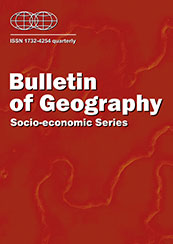Mobile Communications, physical distance and access to follow-up healthcare service in Lagos Metropolis
Mobile Communications, physical distance and access to follow-up healthcare service in Lagos Metropolis
Author(s): Femi Ola Aiyegbajeje, Dickson Dare AjayiSubject(s): Geography, Regional studies, Communication studies, Health and medicine and law, Demography and human biology, Rural and urban sociology, Socio-Economic Research
Published by: Wydawnictwo Naukowe Uniwersytetu Mikołaja Kopernika
Keywords: mobile communications; follow-up; healthcare services; physical distance; Lagos-Nigeria;
Summary/Abstract: The widespread use of mobile communications has resulted in a new practice in family and social life, with significant implications for physical distance. This is because mobile communication allows users to overcome spatial issues such as distance to healthcare services, shift to person-to-person connectivity, and the blur boundaries between one point and another. The uneven distribution of healthcare facilities and distances among them has compounded the provision of follow-up care services to healthcare seekers. Therefore, this paper examined the relationship between the use of mobile telephone to access follow-up healthcare services and physical distance separating out-patients from healthcare centres. The unified theory of acceptance and use of technology (UTAUT) model provided the framework for the study. Using a systematic random sampling technique, a structured questionnaire focusing on socio-demographic characteristics (gender, age, and income), mobile telephone usage for follow-up healthcare services and its effect on physical distance, was administered on 370 respondents at Lagos University Teaching Hospital (LUTH) Idi-Araba, Lagos. Pearson correlation was used to determine the relationship between the physical distance of patients from the hospital and mobile telephone calls for follow-up healthcare services, and the result revealed a strong positive relationship between them (r = 0.898, p≤0.05). The result indicates that 134 patients used mobile telephone to access follow-up healthcare services. It was also found that physical distance is responsible for 89.8% of mobile telephone calls for follow-up healthcare services. Continuous use of mobile telephone technology to improve the quality of follow-up health care service provision for patient satisfaction is recommended.
Journal: Bulletin of Geography. Socio-economic Series
- Issue Year: 2018
- Issue No: 42
- Page Range: 7-18
- Page Count: 12
- Language: English

